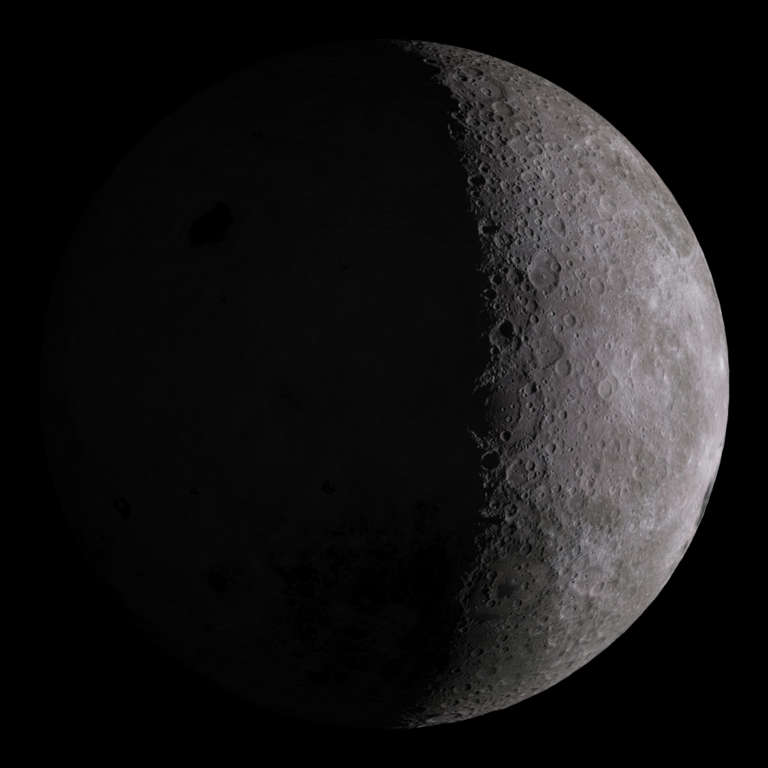Emily Lakdawalla • Apr 28, 2016
The phases of the far side of the Moon
What does the Moon look like in all its phases? Some time ago, Serbian artist Ivica Stošić shared to the Internet a serenely (Selene-ly?) beautiful visualization of the lunar phases. I saw that he had based his animation on spacecraft data (Clementine for the color and albedo, and Kaguya for the topography). I knew those were global data sets, and it occurred to me to ask the question: What would the phases of the Moon look like if it were the far side, not the near side, that stared always at Earth? Stošić responded by animating the phases of the far side of the Moon so that I could see. In this blog post, I'm sharing both animations as well as links to all 385 frames of both animations. If you ever need a view of the Moon in any phase, near or far side, Stošić has you covered.
First, here is the lovely animation that inspired this blog post:
Moon Phase Animation with Beethoven's Piano Sonata No. 14 Simulated view of the near side of the Moon based on Clementine image data (map by Jens Beyer) and JAXA Kaguya topographic data. See the individual frames of this animation here.Video: Ivica Stošić
To make that animation, he rendered 385 frames and then "tweened" them to slow it down. When I asked him to render the frames for the far side, he created the same number, but has not tweened them, so this animation runs much faster. Here you go, the phases of the farside. (He refers to it as the dark side, which I know drives pedants crazy, but I find the name poetical and I know what he means.)
Dark side of the Moon through light phases (simulation) Simulated view of the far side of the Moon based on Clementine image data (map by Jens Beyer) and JAXA Kaguya topographic data. See the individual frames of this animation here.Video: Ivica Stošić
You can download all the original high-definition frames of Stošić's nearside animation here and the frames of the farside animation here. For the nearside animation, the frames are in JPEG format, but for the farside animation, they're in lovely 16-bit PNG format.
So if we lived on an Earth that gazed at the Moon's opposite face, what would its phases look like?
The features of the phases of the farside moon are much more subtle than the bold dark maria of the nearside moon. The first quarter farside moon doesn't have a lot of prominent features on it at all, actually. There is a bright splash on its eastern side (the ejecta of Orientale, and a couple of fresh rayed craters to its north), and other than that the most prominent features are the ringed basins of Korolev and Apollo. As pretty as those two basins are in the high-resolution renderings, I don't know whether they'd be noticeable to the naked-eye glance of the casual afternoon Moon-watcher.

But as the phase of the farside Moon advances toward full,it gets much more interesting. Jackson stands out as an angel of a rayed crater. The south pole-Aitken basin makes a sullen dark stain on the southern half of the Moon. And the dark spot of Mare Moscoviense looks like a hole drilled into the Moon. Looking up at that Moon in my sky, I might wonder what mysteries lie inside that cave.

The waning farside Moon looks much more interesting than the waxing one. It's full of holes! Not just Mare Moscoviense, but also Tsiolkovskiy, Jules Verne, and Aitken. Even more dark spots and holes would appear if you looked at this Moon through a modest telescope. This Moon would rise at midnight, showing its face to us in the witching hour -- maybe we'd see the afternoon, waxing Moon as the smooth, fresh face of the living, and the waning, early-morning Moon as a decayed face of the dead. Or maybe not. What mythologies can you imagine?

Let’s Go Beyond The Horizon
Every success in space exploration is the result of the community of space enthusiasts, like you, who believe it is important. You can help usher in the next great era of space exploration with your gift today.
Donate Today

 Explore Worlds
Explore Worlds Find Life
Find Life Defend Earth
Defend Earth

